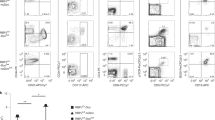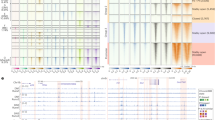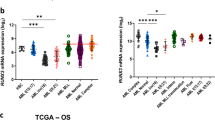Abstract
Notch signaling induces gene expression of the T cell lineage and discourages alternative fate outcomes. Hematopoietic deficiency in the Notch target Hes1 results in severe T cell lineage defects; however, the underlying mechanism is unknown. We found here that Hes1 constrained myeloid gene-expression programs in T cell progenitor cells, as deletion of the myeloid regulator C/EBP-α restored the development of T cells from Hes1-deficient progenitor cells. Repression of Cebpa by Hes1 required its DNA-binding and Groucho-recruitment domains. Hes1-deficient multipotent progenitor cells showed a developmental bias toward myeloid cells and dendritic cells after Notch signaling, whereas Hes1-deficient lymphoid progenitor cells required additional cytokine signaling for diversion into the myeloid lineage. Our findings establish the importance of constraining developmental programs of the myeloid lineage early in T cell development.
This is a preview of subscription content, access via your institution
Access options
Subscribe to this journal
Receive 12 print issues and online access
$209.00 per year
only $17.42 per issue
Buy this article
- Purchase on Springer Link
- Instant access to full article PDF
Prices may be subject to local taxes which are calculated during checkout






Similar content being viewed by others
References
Sambandam, A. et al. Notch signaling controls the generation and differentiation of early T lineage progenitors. Nat. Immunol. 6, 663–670 (2005).
Tan, J.B., Visan, I., Yuan, J.S. & Guidos, C.J. Requirement for Notch1 signals at sequential early stages of intrathymic T cell development. Nat. Immunol. 6, 671–679 (2005).
Radtke, F. et al. Deficient T cell fate specification in mice with an induced inactivation of Notch1. Immunity 10, 547–558 (1999).
Pui, J.C. et al. Notch1 expression in early lymphopoiesis influences B versus T lineage determination. Immunity 11, 299–308 (1999).
Kawamata, S., Du, C., Li, K. & Lavau, C. Overexpression of the Notch target genes Hes in vivo induces lymphoid and myeloid alterations. Oncogene 21, 3855–3863 (2002).
de Pooter, R.F. et al. Notch signaling requires GATA-2 to inhibit myelopoiesis from embryonic stem cells and primary hemopoietic progenitors. J. Immunol. 176, 5267–5275 (2006).
Bell, J.J. & Bhandoola, A. The earliest thymic progenitors for T cells possess myeloid lineage potential. Nature 452, 764–767 (2008).
Weber, B.N. et al. A critical role for TCF-1 in T-lineage specification and differentiation. Nature 476, 63–68 (2011).
García-Ojeda, M.E. et al. GATA-3 promotes T-cell specification by repressing B-cell potential in pro-T cells in mice. Blood 121, 1749–1759 (2013).
Ardavin, C., Wu, L., Li, C.L. & Shortman, K. Thymic dendritic cells and T cells develop simultaneously in the thymus from a common precursor population. Nature 362, 761–763 (1993).
Wada, H. et al. Adult T-cell progenitors retain myeloid potential. Nature 452, 768–772 (2008).
Feyerabend, T.B. et al. Deletion of Notch1 converts pro-T cells to dendritic cells and promotes thymic B cells by cell-extrinsic and cell-intrinsic mechanisms. Immunity 30, 67–79 (2009).
Schlenner, S.M. et al. Fate mapping reveals separate origins of T cells and myeloid lineages in the thymus. Immunity 32, 426–436 (2010).
Luc, S. et al. The earliest thymic T cell progenitors sustain B cell and myeloid lineage potential. Nat. Immunol. 13, 412–419 (2012).
De Obaldia, M.E., Bell, J.J. & Bhandoola, A. Early T-cell progenitors are the major granulocyte precursors in the adult mouse thymus. Blood 121, 64–71 (2013).
Kageyama, R., Ohtsuka, T. & Kobayashi, T. The Hes gene family: repressors and oscillators that orchestrate embryogenesis. Development 134, 1243–1251 (2007).
Jarriault, S. et al. Signalling downstream of activated mammalian Notch. Nature 377, 355–358 (1995).
Nishimura, M. et al. Structure, chromosomal locus, and promoter of mouse Hes2 gene, a homologue of Drosophila hairy and Enhancer of split. Genomics 49, 69–75 (1998).
Tomita, K. et al. The bHLH gene Hes1 is essential for expansion of early T cell precursors. Genes Dev. 13, 1203–1210 (1999).
Ishibashi, M. et al. Targeted disruption of mammalian hairy and Enhancer of split homolog-1 (HES-1) leads to up-regulation of neural helix-loop-helix factors, premature neurogenesis, and severe neural tube defects. Genes Dev. 9, 3136–3148 (1995).
Wendorff, A.A. et al. Hes1 is a critical but context-dependent mediator of canonical Notch signaling in lymphocyte development and transformation. Immunity 33, 671–684 (2010).
Murata, K. et al. Hes1 directly controls cell proliferation through the transcriptional repression of p27Kip1. Mol. Cell. Biol. 25, 4262–4271 (2005).
Wong, G.W., Knowles, G.C., Mak, T.W., Ferrando, A.A. & Zuniga-Pflucker, J.C. HES1 opposes a PTEN-dependent check on survival, differentiation, and proliferation of TCRβ-selected mouse thymocytes. Blood 120, 1439–1448 (2012).
Zhang, D.E. et al. Absence of granulocyte colony-stimulating factor signaling and neutrophil development in CCAAT enhancer binding protein α-deficient mice. Proc. Natl. Acad. Sci. USA 94, 569–574 (1997).
Welner, R.S. et al. C/EBPσ is required for development of dendritic cell progenitors. Blood 121, 4073–4081 (2013).
Ross, D.A. et al. Functional analysis of Hes-1 in preadipocytes. Mol. Endocrinol. 20, 698–705 (2006).
Klinakis, A. et al. A novel tumour-suppressor function for the Notch pathway in myeloid leukaemia. Nature 473, 230–233 (2011).
Sakata-Yanagimoto, M. et al. Coordinated regulation of transcription factors through Notch2 is an important mediator of mast cell fate. Proc. Natl. Acad. Sci. USA 105, 7839–7844 (2008).
Taghon, T., Yui, M.A. & Rothenberg, E.V. Mast cell lineage diversion of T lineage precursors by the essential T cell transcription factor GATA-3. Nat. Immunol. 8, 845–855 (2007).
Kondo, M., Weissman, I.L. & Akashi, K. Identification of clonogenic common lymphoid progenitors in mouse bone marrow. Cell 91, 661–672 (1997).
Igarashi, H., Gregory, S.C., Yokota, T., Sakaguchi, N. & Kincade, P.W. Transcription from the RAG1 locus marks the earliest lymphocyte progenitors in bone marrow. Immunity 17, 117–130 (2002).
Yang, Q. et al. T cell factor 1 is required for group 2 innate lymphoid cell generation. Immunity 38, 694–704 (2013).
Laiosa, C.V., Stadtfeld, M., Xie, H., de Andres-Aguayo, L. & Graf, T. Reprogramming of committed T cell progenitors to macrophages and dendritic cells by C/EBPα and PU.1 transcription factors. Immunity 25, 731–744 (2006).
Wölfler, A. et al. Lineage-instructive function of C/EBPα in multipotent hematopoietic cells and early thymic progenitors. Blood 116, 4116–4125 (2010).
Taghon, T., Yui, M.A., Pant, R., Diamond, R.A. & Rothenberg, E.V. Developmental and molecular characterization of emerging β- and γδ-selected pre-T cells in the adult mouse thymus. Immunity 24, 53–64 (2006).
Ikawa, T., Kawamoto, H., Goldrath, A.W. & Murre, C. E proteins and Notch signaling cooperate to promote T cell lineage specification and commitment. J. Exp. Med. 203, 1329–1342 (2006).
Masuda, K. et al. Prethymic T-cell development defined by the expression of paired immunoglobulin-like receptors. EMBO J. 24, 4052–4060 (2005).
Sasai, Y., Kageyama, R., Tagawa, Y., Shigemoto, R. & Nakanishi, S. Two mammalian helix-loop-helix factors structurally related to Drosophila hairy and Enhancer of split. Genes Dev. 6, 2620–2634 (1992).
Zhang, P., Yang, Y., Nolo, R., Zweidler-McKay, P.A. & Hughes, D.P. Regulation of NOTCH signaling by reciprocal inhibition of HES1 and Deltex 1 and its role in osteosarcoma invasiveness. Oncogene 29, 2916–2926 (2010).
Del Real, M.M. & Rothenberg, E.V. Architecture of a lymphomyeloid developmental switch controlled by PU.1, Notch and Gata3. Development 140, 1207–1219 (2013).
Takebayashi, K. et al. Structure, chromosomal locus, and promoter analysis of the gene encoding the mouse helix-loop-helix factor HES-1. Negative autoregulation through the multiple N box elements. J. Biol. Chem. 269, 5150–5156 (1994).
Zhang, P. et al. Enhancement of hematopoietic stem cell repopulating capacity and self-renewal in the absence of the transcription factor C/EBPα. Immunity 21, 853–863 (2004).
de Boer, J. et al. Transgenic mice with hematopoietic and lymphoid specific expression of Cre. Eur. J. Immunol. 33, 314–325 (2003).
Franco, C.B. et al. Notch/Delta signaling constrains reengineering of pro-T cells by PU.1. Proc. Natl. Acad. Sci. USA 103, 11993–11998 (2006).
Paroush, Z. et al. Groucho is required for Drosophila neurogenesis, segmentation, and sex determination and interacts directly with hairy-related bHLH proteins. Cell 79, 805–815 (1994).
Nakahara, F. et al. Hes1 immortalizes committed progenitors and plays a role in blast crisis transition in chronic myelogenous leukemia. Blood 115, 2872–2881 (2010).
Li, L., Leid, M. & Rothenberg, E.V. An early T cell lineage commitment checkpoint dependent on the transcription factor Bcl11b. Science 329, 89–93 (2010).
Ikawa, T. et al. An essential developmental checkpoint for production of the T cell lineage. Science 329, 93–96 (2010).
Zhang, J.A., Mortazavi, A., Williams, B.A., Wold, B.J. & Rothenberg, E.V. Dynamic transformations of genome-wide epigenetic marking and transcriptional control establish T cell identity. Cell 149, 467–482 (2012).
Mansson, R. et al. Single-cell analysis of the common lymphoid progenitor compartment reveals functional and molecular heterogeneity. Blood 115, 2601–2609 (2010).
Acknowledgements
We thank L. Raetzman (University of Illinois at Urbana-Champaign) for Hes1−/− mice (used with permission from R. Kageyama (Kyoto University Institute for Virus Research)); P. Zweidler-McKay (University of Texas MD Anderson Cancer Center) for mutant Hes1 constructs; A. Chi for advice on the design of luciferase reporter constructs; and N. Speck, D. Allman, S. Reiner, Q. Yang, S. Zhang, W. Bailis and D. Northrup for critical comments on the manuscript. Supported by the US National Institutes of Health (AI059621 and AI098428 to A.B., AI047833 to W.S.P., T32 GM-007229 and T32 CA-009140 to M.E.D., 1-F32-AI-080091-01A1 to J.J.B. and F30-HL-099271 to D.A.Z.).
Author information
Authors and Affiliations
Contributions
M.E.D., J.J.B. and A.B. designed the study and did the experiments; X.W., C.H., Y.Y.-O., D.A.Z., D.A.S. and J.H.D. did experiments; W.S.P. contributed conceptual expertise and provided input into the design of the study; and M.E.D. and A.B. wrote the paper.
Corresponding author
Ethics declarations
Competing interests
The authors declare no competing financial interests.
Integrated supplementary information
Supplementary Figure 1 Hes1-deficient progenitors show defective T cell development after intravenous injection and intrathymic injection.
(a) Photographs of Hes1−/− or Hes1+/+ embryos and flow cytometry analysis of fetal thymi (E15.5) (b) Flow cytometry of mixed irradiation chimeras made by intravenously injecting a mixture of either CD45.2+ Hes1−/− or Hes1+/+ littermate control FL (E15.5) and competitor CD45.1+ BM. Recipient mice were examined 8-10 weeks post reconstitution. (c) Flow cytometry of thymus from CD45.1+ recipient mice injected intrathymically with a mixture of CD45.2+ FL progenitors (Lin−Kit+Flt3+) sorted from Hes1−/− or Hes1+/+ littermate control embryos (15.5 dpc) and sorted CD45.1+ BM progenitors (Lin−Sca1+Kit+Flt3+) and intrathymically injected into sublethally irradiated CD45.1+ recipient mice. Recipient mice were examined 17 days post-injection.
Supplementary Figure 2 Developmental potential of Hes1-deficient progenitors in OP9 and OP9-DL4 cultures.
(a) Flow cytometry of OP9 cultures using FL Lin-Kit+Flt3+IL-7Rα- multipotent progenitors or Lin-Kit+Flt3+IL-7Rα+ lymphoid progenitors sorted from Hes1-/- or Hes1+/+ littermate control embryos (E12.5-13.5). Cultures were harvested after 6 days to assay for the presence of myeloid cells and B cells (b-c) Flow cytometry of OP9 -DL4 cultures using FL Lin-Kit+Flt3+IL-7Rα- multipotent progenitors or Lin-Kit+Flt3+IL-7Rα+ lymphoid progenitors sorted from Hes1-/- or Hes1+/+ littermate control embryos (E12.5-13.5). Cultures were harvested 7 days after plating to assay for the presence of (b) T cells, and (c) myeloid cells. Results are representative of three independent experiments.
Supplementary Figure 3 Hes1-deficient prethymic T cell progenitors show defective T cell development in OP9-DL4 cultures.
(a) Flow cytometry of fetal liver from Hes1-/- or Hes1+/+ littermate control embryos (E12.5-13.5). (b) Flow cytometry of OP9-DL4 cultures using prethymic T cell progenitors (Lin-Kit+Flt3+IL-7Rα+PIR+ or PIR-) sorted from Hes1-/- or Hes1+/+ littermate control fetal liver (E12.5-13.5) (200 cells/well). Cultures were analyzed by flow cytometry after 6 days. Triplicate wells were set up for each experimental group. Bar graph represents mean cell number per well. Error bars represent SEM. Results are representative of two experiments.
Supplementary Figure 4 Hes1-deficient multipotent fetal liver progenitors cultured with Notch ligands have higher expression of Cebpa mRNA.
Flow cytometry and qPCR of OP9-DL4 cultures using FL progenitors (Lin-Kit+Flt3+) sorted from Hes1-/- or Hes1+/+ littermate control embryos (E15.5). After 6 days, Mac1-CD25- cells were sorted for qPCR analysis. Shown are mean mRNA expression levels normalized based on GAPDH levels.
Supplementary Figure 5 C/EBP-α deletion restores early and late stages of T cell development in vivo after intravenous injection.
Flow cytometry of hematopoietic lineages in mixed FL chimeras made by intravenously injecting a mixture of CD45.2+Hes1-/- Cebpafl/flVav1Cre, Hes1-/-Cebpafl/+Vav1Cre, or Hes1+/-Cebpafl/flVav1Cre FL and CD45.1+ competitor BM cells into CD45.1+ lethally irradiated recipient mice. After 8-10 weeks, the CD45.2+ donor contribution to each population was assessed.
Supplementary Figure 6 Hes1-mediated constraint of myeloid gene expression programs is essential for T cell development; the thymus is settled by a myelo-lymphoid progenitor from the bone marrow.
Early thymic progenitors (ETP) develop under the influence of Notch signaling in the thymus. Shortly after thymic entry, Notch induces the expression of the transcriptional repressor Hes1, which directly inhibits C/EBP-α, a critical myeloid regulator and perhaps other myeloid lineage genes. Hes1 is expressed in CD4/CD8 double-negative (DN) thymocytes, including ETP, DN2, and DN3 progenitors, but is no longer expressed at the CD4/CD8 double-positive (DP) stage. DN3 and DP thymocytes are committed to the T-cell lineage.
Supplementary information
Supplementary Text and Figures
Supplementary Figures 1–6 (PDF 977 kb)
Rights and permissions
About this article
Cite this article
De Obaldia, M., Bell, J., Wang, X. et al. T cell development requires constraint of the myeloid regulator C/EBP-α by the Notch target and transcriptional repressor Hes1. Nat Immunol 14, 1277–1284 (2013). https://doi.org/10.1038/ni.2760
Received:
Accepted:
Published:
Issue Date:
DOI: https://doi.org/10.1038/ni.2760
This article is cited by
-
Multi-objective optimization reveals time- and dose-dependent inflammatory cytokine-mediated regulation of human stem cell derived T-cell development
npj Regenerative Medicine (2022)
-
How transcription factors drive choice of the T cell fate
Nature Reviews Immunology (2021)
-
A new lymphoid-primed progenitor marked by Dach1 downregulation identified with single cell multi-omics
Nature Immunology (2020)
-
RBPJ-dependent Notch signaling initiates the T cell program in a subset of thymus-seeding progenitors
Nature Immunology (2019)
-
An update on classification, genetics, and clinical approach to mixed phenotype acute leukemia (MPAL)
Annals of Hematology (2018)



